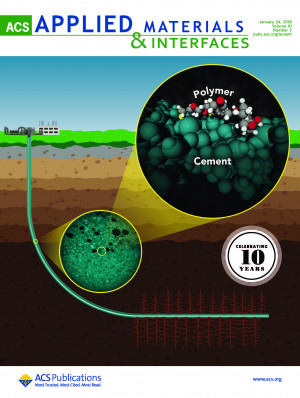Self-Healing Cement Could Be a Boon to Oil & Gas Industry
Simulations Run at NERSC Show How this Unique Material Functions
May 24, 2018
By Kathy Kincade
Contact: cscomms@lbl.gov
Researchers at the U.S. Department of Energy's (DOE) Pacific Northwest National Laboratory (PNNL) have developed a unique cement that can repair itself in as little as a few hours. Such a product would be a boon to the oil and gas industry; wellbore cement for geothermal applications has a lifespan of only 30 to 40 years, and when the cement cracks, which happens often, repairs can easily top $1.5 million per well.
This challenge prompted PNNL chemist Carlos Fernandez and colleagues to create their “self-healing” cement—actually a special composite composed of cement and a polymer—which is suitable for both geothermal and oil and gas applications. With thousands of subsurface energy development wells running annually, this technology can have a dramatic impact on the cost of energy production.
Following a series of laboratory experiments, Fernandez and his team knew the self-healing cement worked, but they didn’t entirely understand how the cement behaves at the molecular level. They wanted to understand what drives the healing ability of these composites, and more specifically they wanted to know the role of sulfur atoms in the polymer. This information would illuminate potential weaknesses in the cement/polymer composite and how to modify the formula to improve durability.
Beyond Molecular Dynamics
With this in mind, Fernandez reached out to PNNL computational scientist Vassiliki-Alexandra Glezakou and her team—which includes Manh-Thuong Nguyen and Roger Rousseau—for help. They constructed a first-of-its-kind model based on density functional theory that can simulate what occurs inside the cement/polymer system and used it in a series of simulations run at Lawrence Berkeley National Laboratory’s National Energy Research Scientific Computing Center (NERSC), a DOE Office of Science User Facility.
This approach goes much further than classical molecular dynamics models that normally cannot track how bonds break and form inside cement, Glezakou noted. As a result, the team built a model complex enough to represent all the salient features of the cement/polymer interface both in a slurry and in a cured state. Their findings were published in ACS Applied Materials & Interfaces and featured on the journal cover.

Large scale ab initio molecular dynamics are used to determine the fundamental interactions between polymer and cement in self-healing cement composites. Image: Vassiliki-Alexandra Glezakou and Cortland Johnson, PNNL
"We had two main challenges: we needed to figure out how to simulate the cement and something more relevant to a cement crack,” said Glezakou. “These were rather unprecedented simulations, not just in terms of computational demands, but especially for creating a molecular model that can provide a reasonable representation of such a complex system."
The results were surprising and went against the team's initial assumptions, she added. The simulations showed that the polymer sulfur atoms do not bind on the cement, but instead point away. This is important because if the sulfur atoms were responsible for the cement's self-healing abilities, like the team previously thought, binding on the cement would hinder this action. Unexpectedly, the main interaction responsible for the adhesion of self-healing cement is the bonding between alkoxide functionalities in the polymer and calcium atoms in the cement. In addition, a large number of hydrogen-bonding interactions, shown to exist over a large range of interatomic interactions, were found to contribute to the reversible binding because they can be as easily broken as they are formed.
The simulations, which were run on NERSC’s Edison system, were modeled by Nguyen on about 900 atoms over the course of a month’s worth of computing.
"These were long, big simulations, and Nguyen did a masterful job teasing out all the information from the trajectories,” said Rousseau. “Modeling 900 atoms using ab initio molecular dynamics is hard. The fine details of these computations and analyses are not for the faint of heart."
Inspired by these findings, the team set out to investigate further using spectroscopic imaging capabilities at the Environmental Molecular Sciences Laboratory, a DOE Office of Science User Facility at PNNL. Sum frequency generation spectroscopy is a tool sensitive to interactions at the interface between the polymer and cement, but also between the polymer and air. This detailed technique isolated the alkoxide-calcium interaction at the cement-polymer interface and validated their role in the healing function of these novel composite materials. This experiment also confirmed the absence of any atomic interactions involving the sulfur atoms in the polymer, further validating the theoretical predictions.
All of this together helped explain how the self-healing cement works and showed that the cement may perform better than originally thought. It also gives the team a better understanding of how and why the materials behave the way they do and may reveal ways to modify and potentially improve it further.
This article is based on materials provided by PNNL.
About NERSC and Berkeley Lab
The National Energy Research Scientific Computing Center (NERSC) is a U.S. Department of Energy Office of Science User Facility that serves as the primary high performance computing center for scientific research sponsored by the Office of Science. Located at Lawrence Berkeley National Laboratory, NERSC serves almost 10,000 scientists at national laboratories and universities researching a wide range of problems in climate, fusion energy, materials science, physics, chemistry, computational biology, and other disciplines. Berkeley Lab is a DOE national laboratory located in Berkeley, California. It conducts unclassified scientific research and is managed by the University of California for the U.S. Department of Energy. »Learn more about computing sciences at Berkeley Lab.







